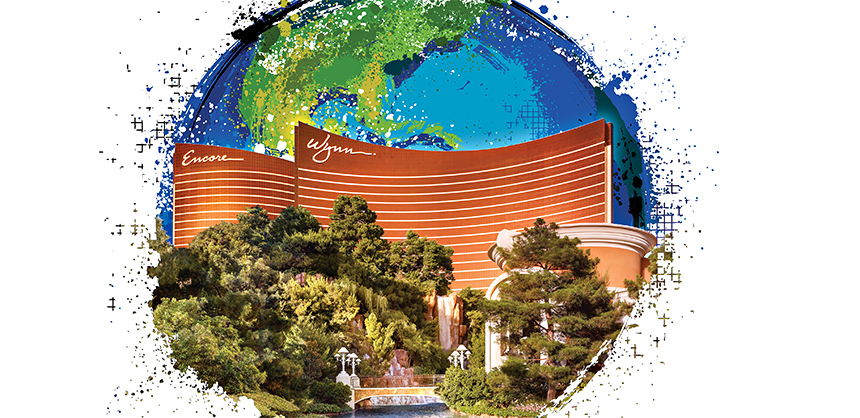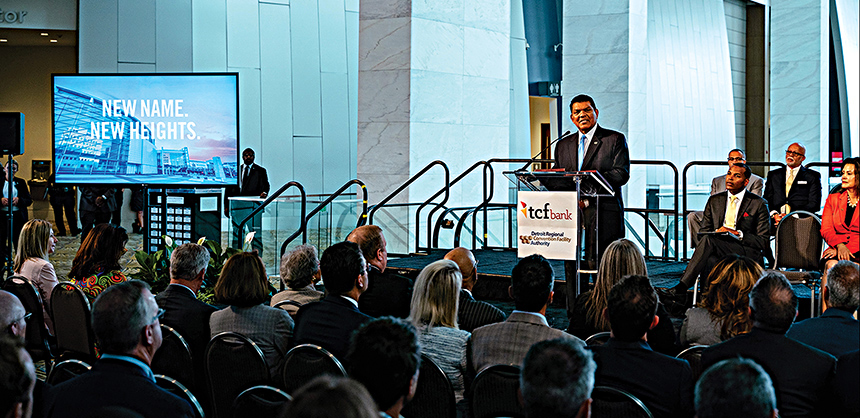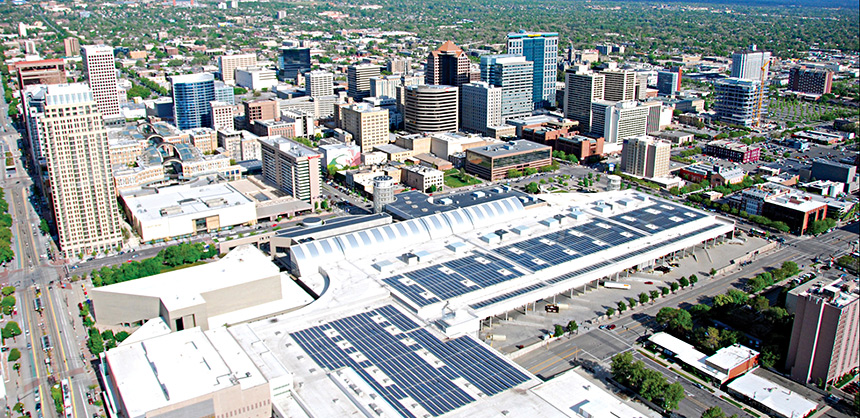Sophisticated SustainabilityAugust 12, 2020
These Venues Are Setting Standards For Green Meetings By Sophia BennettSophisticated Sustainability
These Venues Are Setting Standards For Green Meetings
Traditionally, the phrase “sustainable events” has been synonymous with green or eco-friendly gatherings. But many people have long championed a broader definition of sustainability — one that takes issues such as social justice, equity and inclusion, and corporate social responsibility, into account. Given the current emphasis on social issues, it’s impossible not to think about a more comprehensive definition of the term.
“When you mention sustainability, it means something different to every group,” says Erik Hansen, chief sustainability officer for Wynn Resorts. “Some groups have the definition of ‘I just want to do less harm.’ But there’s a second group that’s even more engaged, and they want to take the route of doing more good with sustainable events.” For those companies, venues are excited to explore all kinds of interesting and exciting possibilities, including corporate social responsibility projects, zero-waste plans and green opportunities for meeting sponsors. Now more than ever, there are chances to make a real impact with sustainable meetings of all kinds, no matter how groups define that key term.
Working With Venues
Meeting sustainability efforts are becoming more sophisticated at the same time they’re becoming more comprehensive. More brands realize their sustainability efforts need to start at the very beginning of their event planning with the RFP. David Fiss, CMP, director of corporate relations, partnerships and event strategy for Sustainable Brands, recommends that planners embed requirements in their RFPs that will jumpstart conversation with sales staff about things like what eco-conscious features they offer and what post-event data they can provide.
Then, before sending the RFP, planners can use some helpful tools to determine what cities should even be allowed to bid. “There’s an emerging awareness around a program called the Global Sustainable Destination Index,” Fiss says. It helps planners understand the various things cities around the globe are doing in terms of environmental sustainability.
Venues know they have an important role to play in the greening of events, and many have really stepped up their games. For example, the Salt Palace Convention Center in Salt Lake City, Utah, managed by ASM Global, recently implemented what they call their “You Are Here Experience,” which is modeled after the United Nations’ 17 sustainable development goals. “We’ve taken those goals and customized them to the event industry, focusing on people, planet and profit,” says Chance Thompson, senior manager, sustainability and public relations. The program covers topics such as creating sustainable cities, reducing inequality and providing affordable, clean energy.
Goal 17 on the UN’s list is “partnership to achieve the goals,” and the Salt Palace has taken this very seriously too. Since 2017, it has worked with four entities — Visit Salt Lake, A/V provider PSAV, caterer Centerplate and the Mountain America Expo Center — to achieve the Events Industry Council’s Sustainable Events Standard. Salt Palace’s staff can now work with planners to help them certify their events to the same standard. It’s important to Thompson to help companies host more sustainable events without too much time and hassle. “Sustainability is not this thing that you just pick up and do,” he reports. “So many clients, I’m finding, they think about it and they care about it, but they’re still trying to figure out where to start and what to do. We understand planning a trade show is not an easy task. That’s why we’ve set up a system and make it really easy for planners.”
The TCF Center in Detroit is another venue that tries to make going green easy for planners. “We make it a point to engage each customer in our sustainability program throughout the life cycle of their event,” says Claude Molinari, general manager of Detroit’s TCF Center, which is also managed by ASM Global. “Our sales department offers sustainability information to customers with their electronic sales kits, on-site visit presentations and on our website, which has a great deal of information that show managers can use to create a green event.”

Officials speak at the TCF Center’s renaming ceremony. The center in Detroit is one of many nationwide that works with planners to help them devise carbon-neutral events. Courtesy of Claude Molinari
Carbon Neutral is Cool
Wynn Las Vegas also has an aggressive sustainability plan that can help planners. Between its off-site and on-site solar arrays, Wynn Las Vegas’ convention space is now powered with 100% renewable energy. Any company seeking to go carbon neutral can get a big bump in meeting its goal from that alone. But Hansen says the company can also determine the exact energy footprint for an event based on the number of guests and duration of visit. “We can calculate how many kilowatt hours of energy they would use on the whole property, not just the event space. Then, we can retire or transfer renewable energy credits to the client for their own sustainability or compliance goals. That gives the client the ability to come to Wynn, hold a meeting and say, ‘Here’s what our environmental impact was and we 100% offset it.’”
Salt Palace also has a large solar array and can offer credits to clients who want to offset some of the carbon emissions associated with their events through renewable energy. In addition, it works with several partners that sell carbon credits, including one called TerraPath. Carbon credits provide money to organizations that engage in activities that neutralize the carbon generated by events, including air travel, food production and energy usage. “We’ve got really strong engagement in this,” Thompson notes. “Two clients last year did carbon and energy offsets. We want to get to the point where offsetting the negative carbon footprint is standard in our industry.”
With the amount of green washing out there, it can be challenging to find a legitimate partner for carbon credits. “You have to be really familiar with the organization that you’re going to support,” says Anna Marie Rembold CMP, CSEP, president of Anna Marie Events. “Really do your research.” She’s a fan of a nonprofit called Health in Harmony, which is empowering local people to save the rain forests in Borneo.
Another way that firms are cutting their carbon footprint is by rethinking their food choices. “Where is the food coming from and what is the footprint?” Fiss says. Sourcing from local farms and ranches significantly lowers the amount of energy used to get it to an event.
Zero Waste is Hot
Cutting waste is a growing part of creating a sustainable event. “Because the convention center generates nearly 650 tons of waste a year, it becomes imperative that we take every measure possible through reuse, recycling and reduction of waste to get as close as we can to a zero-waste operation,” Molinari says. “Each year, the TCF Center Green Committee works hard to increase the diversion rate of the venue’s waste management operation. This year, we are on track to achieve a 50% diversion rate.”
With some pre-event planning, planners can easily reduce the amount of waste coming into an event. For example, at the TCF Center, companies can use the digital signage system instead of print materials to provide way finding and announcements for guests. “We encourage the most minimal amount of printed items,” Rembold says. Apps and other electronic tools can take the place of many program books and brochures.
Post-event donation programs are becoming very popular. “We have a network of over 100 nonprofits and small businesses that we donate our leftover trade show materials to,” Thompson says. So far, these partners have received more than 800,000 pounds of goods and 100,000 meals.
Wynn Las Vegas has several policies to eliminate waste, in addition to maintaining a donation program for nonprofits and schools. “As part of the Zero Carbon, Zero Waste program, there are no single-use plastics anywhere in event services, including water bottles,” Hansen says. “We partner with a company called Proud Source to provide all aluminum water bottles. We can recycle and upcycle any of the materials that are coming into the facility. We keep 90% away from the landfill.”

The Salt Palace Convention Center in Salt Lake City, Utah has a large solar array and offers credits to offset carbon emissions from events.
Talking About Sustainability
It used to be difficult to get guests, exhibitors and sponsors interested in sustainability. Now, it’s on everyone’s mind. “One of the things that we’re starting to see with planners is they want a method to tell the stories of whatever they’re going to achieve [around sustainability],” Thompson says. “Some clients want to really focus in on zero waste. Others just want to do a community service project. Some people may look at that and say, ‘They’re only doing it for the PR.’ But I think they’re doing it because they’re proud of it and stakeholders want to hear the story.”
Thompson provides an example of how communication can not only tell a positive story but improve event outcomes. Salt Palace Convention Center hosted a large solar energy trade show last September. The organizers wanted to make big improvements to their zero-waste strategy. When Thompson told them about the You Are Here Experience, which has a set of appealing graphics that help communicate the program’s goals, the organizers were so excited they adapted the icons for their own use. “It inspired them from a zero-waste standpoint, but also around equality and other goals,” he says. “It was cool to see them take a large communication strategy, and it helped them engage with their stakeholders in a way they never had before.” One of the biggest outcomes was that the trade show tripled the amount of material that was donated and was able to divert 118,000 pounds of material from the landfill.
Communicating the company’s goals around social sustainability for the event can also lead to better outcomes for the firm and attendees. These days it’s not uncommon to add a CSR component to conferences, meetings and even incentive trips. “It’s good for PR, but people also love it,” Hansen says. “They leave feeling like they had a great time, but they also did something good for the community. The key we see is getting information out in the right way. You want to deliver the message in a way that’s smart and doesn’t seem like it’s being pushed in your face and you have to do this. We prefer to do it through more subtle communication about doing the right thing.”
Increasingly, communicating about going green can also bring in green. “Something that we introduced to one of our clients is creating a whole list of sustainability-driven sponsorship packages,” Rembold says. “Interestingly, those sponsorship packages were the first to sell.”
Sustainability and COVID-19
The coronavirus pandemic has affected every corner of our lives, so it comes as no surprise that event sustainability efforts are not immune. Those interviewed saw both worrying and hopeful signs for the future of green events. The biggest setback is the marked increase in single-use items. Although face masks and gloves are a concern, one of the main areas where this switch is happening is in food service. “Buffets are going to struggle a lot,” Thompson says. “They may become a thing of the past. If that’s the case, you’re probably going to see grab-and-go become more of a priority, so that’s a concern from a zero-waste perspective.”
Rembold thinks served buffets may provide an alternative that will keep this service option alive. “Food safety has to come first, but I hope we don’t slide completely backward in terms of packaging and waste,” she adds.
Fiss, too, sees this as an opportunity to think about how to use more sustainable packaging. Instead of putting meals in plastic containers, they could go in reusable lunch boxes that can be sanitized. “That creates jobs, too, as opposed to eliminating them,” he says. “Events have always driven a lot of jobs and we want to make sure the jobs are still there.”
But there’s no doubt in anyone’s mind that sustainability will become a focus for meeting planners again. “It was paused for a little while, but now people are talking about again,” Hansen says. “Even in just the last five years it’s become the norm. The world has really flipped a switch with sustainability.”
In fact, professionals actually see many positive things coming out of the current crisis. Hansen is cheered by how the pandemic has sped up digital adoption. This change is likely to carry over and make it much easier for companies to use apps and online resources that cut paper. “Early communication to attendees is key,” he warned, so people have time to download and get familiar with the conference app and other tools like QR code readers.
“There’s still so much value in in-person events, but at the same time, there’s undeniable value [from an environmental standpoint] in going virtual,” Rembold says. “My view right now is that we’re going to start seeing more hybrid events going forward.”
Fiss has no doubt live meetings will rebound. “There’s a place for virtual, there’s a place for hybrid, but there’s a place for that in-person connection,” he says. “If you look at the history of humankind, we’ve been migrating and coming together for celebrations and convenings for a long time. But I do think people will ask themselves more often, ‘Is there a business value to having a meeting? Is there a clear business objective?’ If the answer is yes, they’ll ask themselves, ‘How do we come together sustainably?’”
Thompson thinks there will be much more emphasis on the cleanliness of events going forward. Salt Palace is in the process of becoming Global Biorisk Advisory Council STAR-certified. The program helps facilities ensure they can provide the safest, most hygienic environment possible. In addition to establishing and maintaining a system for disinfecting and cleaning spaces, managers must develop a three-step process outlining how they will prepare for a biorisk incident, respond and contain it, and return to normal operations.
Fiss is generally optimistic that the pandemic will help the sustainable events industry. “My hypothesis is that sustainable events are more thoughtful because you have to think about everything,” he says. “You have to go through and turn over every stone. COVID will do the same thing. People will rethink everything.”
Thompson can even see some important system changes coming as we move into a “new normal.” Salt Palace is incorporating components of the circular economy into its sustainability efforts. The Ellen MacArthur Foundation defines the circular economy as a system focused on designing out waste and pollution, keeping products in use for the entirety of their usable life and regenerating natural and social systems.
As one example of how this can work, the facility recently provided the nonprofit Utah Arts Alliance with upcycled materials for an art exhibit called Dreamscapes. “In the first six months they were open, they generated over $500,000 in brand-new revenue and hired 12 new people,” he says.
Many of those visitors attended events at the Salt Palace; the venue provided referrals and discount codes to people interested in checking out the exhibits. By rethinking its supply chain and how it deals with waste, and looking for ways to improve its community at the same time, the Salt Palace is connecting to that broader definition of sustainability that is becoming more important in today’s marketplace. C&IT








